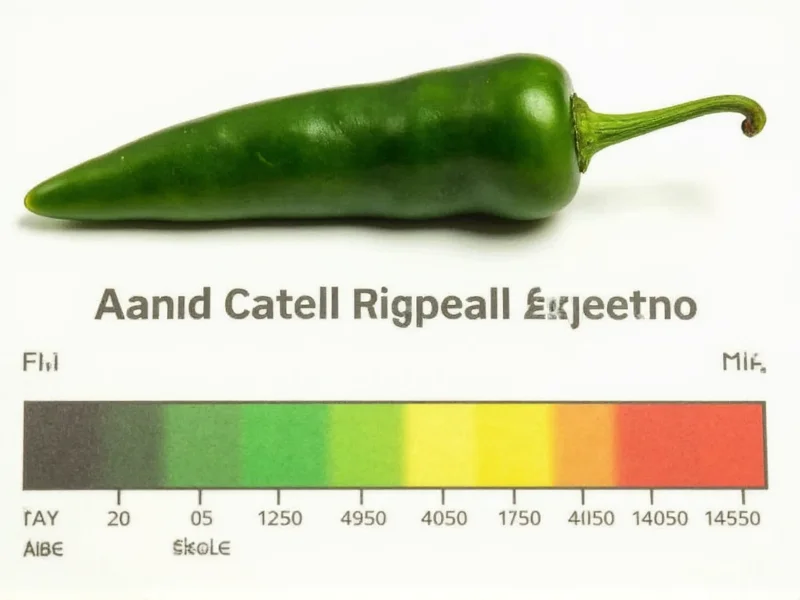Understanding where jalapeños fall on the Scoville scale helps home cooks, food enthusiasts, and culinary professionals make informed decisions about spice levels in their dishes. The Scoville scale, developed by pharmacist Wilbur Scoville in 1912, measures the pungency or spiciness of chili peppers and other spicy foods by quantifying their capsaicin concentration.
What the Scoville Scale Measures
The Scoville scale measures the concentration of capsaicinoids, primarily capsaicin, which triggers the burning sensation we perceive as "heat" when consuming chili peppers. Originally, the scale relied on human taste testers diluting pepper extracts until the heat became undetectable. Today, high-performance liquid chromatography (HPLC) provides precise measurements, though results are still converted to Scoville Heat Units for consumer understanding.
Why Jalapeños Have a Range of Heat Levels
Unlike some peppers with more consistent heat profiles, jalapeños exhibit significant variation in their Scoville ratings due to several factors:
- Growing conditions: Soil quality, climate, and water stress affect capsaicin production
- Ripeness: Red jalapeños (fully ripe) tend to be hotter than green ones
- Genetic variation: Different cultivars have been bred for varying heat levels
- Plant stress: Peppers produce more capsaicin when under environmental stress
- Seed and membrane content: The white pith and seeds contain the highest concentration of capsaicin
Comparing Jalapeño Heat to Other Common Peppers
To better understand where jalapeños fit in the spectrum of chili pepper heat, consider this comparison of popular peppers on the Scoville scale:
| Pepper Type | Scoville Heat Units (SHU) | Heat Level |
|---|---|---|
| Bell Pepper | 0 SHU | Mild |
| Poblano | 1,000-2,000 SHU | Mild |
| Jalapeño | 2,500-8,000 SHU | Medium |
| Serrano | 10,000-23,000 SHU | Medium-Hot |
| Cayenne | 30,000-50,000 SHU | Hot |
| Habanero | 100,000-350,000 SHU | Very Hot |
| Ghost Pepper | 855,000-1,041,427 SHU | Extremely Hot |
Practical Implications of Jalapeño Heat Levels
Knowing that jalapeños measure between 2,500 and 8,000 Scoville units helps in culinary applications. For most palates, this represents a noticeable but manageable heat that enhances flavor without overwhelming other ingredients. When working with jalapeños, consider these practical tips:
- Remove seeds and white membranes to reduce heat by up to 80%, as these contain the highest capsaicin concentration
- Wear gloves when handling hot peppers to avoid transferring capsaicin to sensitive areas
- Pair jalapeños with dairy products like yogurt or sour cream to counteract heat, as casein binds to capsaicin
- Understand that cooking doesn't eliminate capsaicin but can distribute it more evenly throughout a dish
- Consider that individual heat perception varies significantly based on genetics and tolerance
Measuring Jalapeño Heat in Home Settings
While professional Scoville measurements require laboratory equipment, home cooks can assess jalapeño heat through careful tasting. Start with a small piece of the pepper's flesh (avoiding seeds initially), wait 30 seconds, then evaluate the heat level. Remember that heat perception builds over time and can vary based on individual tolerance.
For those seeking consistent heat levels in recipes, consider purchasing jalapeños from the same source consistently, as commercial growers often maintain more uniform conditions than home gardens. Some specialty growers even label their jalapeños with specific heat ranges for culinary precision.
Understanding Jalapeño Varieties and Their Heat Differences
Not all jalapeños are created equal when it comes to heat measurement on the Scoville scale. Several cultivated varieties exist with different heat profiles:
- Standard Jalapeño: The most common variety, typically falling in the middle of the 2,500-8,000 SHU range
- Mucho Nacho Jalapeño: Bred for slightly milder heat, often closer to 2,500-4,000 SHU
- Early Jal: Known for consistent medium heat, usually around 4,000-6,000 SHU
- Grande Jalapeño: Tends toward the higher end of the scale, sometimes reaching 7,000-8,000 SHU
- Chipotle: A smoked, ripe jalapeño that maintains similar heat levels but with altered flavor profile
When exploring the question of what is a jalapeño on the Scoville scale, it's important to recognize that this versatile pepper occupies a sweet spot in the heat spectrum—hot enough to provide noticeable spice but mild enough to be accessible to most palates. This balance explains why jalapeños remain one of the most popular chili peppers worldwide, featured in everything from salsas and nachos to stuffed peppers and pickled varieties.











 浙公网安备
33010002000092号
浙公网安备
33010002000092号 浙B2-20120091-4
浙B2-20120091-4